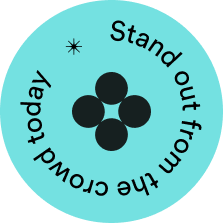
Brand Awareness
Building brand awareness is crucial for business’ growth and long-term success, but you need to do it in a targeted fashion to achieve the best results.
Why brand awareness matters
Building and maintaining brand awareness is a crucial goal for most marketers. If you can achieve it, the job of communicating the unique benefits of your product or service, and encouraging customers to buy from you, is significantly easier.
The ability to measure and demonstrate high brand awareness can also help you prove the return on investment (ROI) your marketing activities are delivering.
If you’re currently in the process of rethinking your marketing and asking which goals make the most sense for your company, it’s worth taking the time to explore the concept of brand awareness and what you could be doing to get better results in this area.


Why brand awareness is important in marketing
When your business is focused on value-generating, measurable outcomes like expanding your customer base and driving revenue generation, it’s reasonable to ask why less tangible goals – such as brand building – should be a priority.
But there are some clear and powerful reasons why brand awareness is an important objective to focus on.

Brand recognition and association
If you’re a small business, still working hard to make a mark and find a niche in your industry, one of the first milestones on your journey is simply getting potential customers familiar with your brand and what you can offer.
Effective awareness-raising campaigns can help you reach the point where potential buyers not only recognise key brand elements like your name and logo, but make quick associations between these features and your product or service.
The potential value of brand recognition and association can be seen in the most extreme examples of successful brands. The enormous power of the Apple logo and everything it represents, for example, is a big part of the reason why so many people buy Apple products and have enduring brand loyalty to the company.
Trust
Customers today have a lot of choice, which means you have to work hard to gain their business by showing you can deliver on the promises made in your marketing. A key element of this equation is trust, which has been shown to have an impact on the purchase decisions people make.
Building brand awareness, to the point that people feel a bond of trust with you, will be a huge boost to your efforts not only to win new customers, but to establish strong, lasting relationships with them.
A key reason why so many people buy Ford cars, HP laptops and Nike trainers, for example, is because they not only recognise those established brands, but also trust that when they purchase from them, they will receive a high-quality, reliable product.


Reduced customer acquisition costs
Once your marketing activities start to deliver positive results on the brand awareness front, you’re already well on your way to increasing sales and bringing in more revenue, because a growing base of customers are familiar with your company and what you do.
When potential buyers already have this underlying recognition and engagement with your brand, you don’t need to work quite as hard to win their business. As a result, your customer acquisition costs are reduced.
Earning brand equity
Over time, brand awareness and recognition can lead to brand equity: the value your brand holds for the business. It’s through effective marketing and the delivery of positive experiences for your customers that you accumulate brand equity.
This can lead to a number of valuable results for the business, including the opportunity to increase your prices in line with the value your audience associates with your brand. Many customers will be willing to pay higher prices for a product or service they know is of a certain quality. Again, the likes of Apple, Mercedes and luxury brands like Louis Vuitton and Chanel are proof of this.

Other potential advantages that can result from strong brand equity include:
- Higher stock prices
- Opportunities to successfully expand into new markets and product lines
- The ability to have a positive impact on society and the wider world through the strength and influence of your brand
Creating and maintaining brand awareness
It goes without saying that brand awareness is important, so what steps should you be taking to build and maintain it?
There’s no denying the power of video marketing in any company’s brand strategy, regardless of the exact goals you’re trying to achieve.
When it comes to building and maintaining awareness, brand videos can be hugely effective. Video is an engaging and entertaining format that gives you the power to make a strong and lasting impression on your audience.
It’s also an excellent way to inject some character and individuality into your brand, which is crucial if you want to set yourself apart from your competitors and get people to remember you. What’s more, videos are highly shareable, a quality that makes them ideally suited to the task of getting as many eyes as possible on your brand and your key messages.
Guest content – a blog that you create and publish on a third-party website, for example – can be an effective way to build brand recognition and awareness. It gives you the opportunity to benefit from the traffic already heading to other sites and users’ existing familiarity and engagement with those platforms.
Invest the time and expertise required to ensure every piece of guest content you create is of a certain quality and genuinely relevant and helpful to your target audience. This is crucial if you want to make a great impression on new customers and inspire them to take the step from reading your content to finding out more about your brand.
Human beings are hardwired to respond to a compelling story. From tales told around campfires to engaging narratives that unfold and evolve purely in the realm of social media, there are countless ways stories can impact our lives and leave an impression on us. It makes sense, then, to make storytelling a key component of your brand and marketing strategy.
As part of your branding campaign and strategy planning, think about the story behind your business, the key themes within it and how you can get these messages across to your audience.
Ask questions like:
- Why was our business created?
- What defines us and makes us different from our competitors?
- How do we want to make a difference to the world?
Social media is an invaluable resource that every business should put at the centre of its brand strategy. It’s particularly important when you want to build recognition and awareness, simply because of the reach it provides and the sheer number of people who use social platforms.
Here are a few statistics that emphasise the power of social media:
- There are more than 4.4 billion social media users around the world
- That equates to more than half of the global population
- More than nine out of ten internet users log onto social platforms every month
- Six social media channels now attract more than one billion monthly active users
- Facebook alone has more than 2.8 billion monthly active users
If social media isn’t one of the first things you think about when you’re planning digital marketing activities to increase brand awareness, you’re depriving yourself of an enormous opportunity.
Advertising may be more directly associated with promoting products and driving sales than raising awareness, but it’s nevertheless true that an effective advertising strategy will help you increase the number of people who are familiar with your brand.
Consider sponsored content in social media feeds, for example. A large number of people who see promoted posts will simply scroll past them without clicking, but just seeing your name, registering your logo and gaining some idea of your product offering could be enough to influence their future purchasing decisions.

How to develop a brand awareness strategy
Like any element of marketing, building brand awareness needs to be backed up by a strong and carefully thought out strategy.
Make sure you dedicate sufficient time and resources to planning your own strategy and monitoring performance after it has been implemented.


Research your audience
If you want to build awareness of your brand among your target audience, first you need to have a strong grasp of what defines your customers and their most common habits and preferences.
There are a number of key questions you need to answer at this stage. One of the most important is: where do your audience spend most of their time online? Identifying the websites, social media platforms, groups and other digital domains that are most attractive to your customers will help you refine your understanding of them. Furthermore, it will inform your thinking about where to focus your marketing activities to have the biggest impact.
Your knowledge about your audience will also be crucial in helping you decide what targeting methods will deliver the best results, particularly where advertising is concerned. Contextual targeting, for example, involves placing ads alongside content that relates to your brand and your product offering.
Evaluate different content types
A key stage in any marketing strategy is exploring the various content types and formats available to you and making decisions about which ones are best suited to your needs.
Here are some options to consider:
- Infographics: Attention-grabbing, easy to consume and highly shareable, infographics are an excellent way to build brand awareness by attracting people’s interest and showcasing your knowledge of a particular subject. This can naturally lead into conversations about how your skills and expertise can help your customers.
- Blog posts: A fundamental part of any content marketing strategy, blog posts can help you increase brand awareness in various ways. If you’ve done a good job with your search engine optimisation efforts, for example, when someone types a relevant query into Google, your blog should rank well in the results. This is one of the most immediate and natural ways for new customers to discover your brand.
- Quirky social media content: Social media provides the perfect opportunity to adopt a more informal approach to your marketing and take some chances that will capture people’s attention and get them talking about you. Whether it’s a lighthearted quiz, a unique take on current trends in your industry or unconventionally designed custom graphics, don’t be afraid to try new things that will help you stand out from the crowd.
Create a dedicated content strategy
Researching and analysing the different content types that can help you generate brand awareness should be part of a wider effort to create a comprehensive content strategy.
A central theme within this should be your brand’s story. A compelling story, effectively told through your marketing, will help you make personal, emotional connections with customers, which is key for them to not only remember you, but have the confidence to buy from you.

Another important decision to make is where you want to position your most valuable pieces of awareness-raising content. One of the first things a potential customer will do when they have just discovered your brand and want to find out more about you is browse your website, so make sure you have lots of well-designed, engaging pages across your site. Your About Us page, for example, provides an excellent opportunity to make a good impression on visitors and present a compelling picture of your company culture.

It’s also worth coming up with a plan for more in-depth content, such as downloadable guides and whitepapers. Assets such as these can make a big contribution to your awareness-building activities if your target audience has complex, in-depth questions they want answers to. If you’re a provider of cloud-based accounting software, for example, a dedicated guide could help to educate your customers on the benefits they can gain from moving their financial processes to the cloud, common challenges they might face and how to find a solution that suits their needs.

Find the right social media platforms
Social media provides the necessary fuel to supercharge any marketing campaign, but to get the best possible results from this area of your marketing, you need to be sure you’re using the right strategy.
A key aspect of this is identifying the social platforms that provide the best opportunities to connect with your target audience and make an impression on them.
When you’re researching your audience and coming up with your buyer personas, think about the platforms that are most attractive to your ideal buyers and will facilitate positive engagement and discussions with them.
This decision will also be informed by the nature of your business and the product or service you provide. LinkedIn is likely to be the first port of call for B2B firms, for example, while companies that rely on visual marketing to sell their products – fashion brands, for instance – will gravitate towards Instagram.
Measuring brand awareness
Brand awareness isn’t as easily quantifiable as other common marketing goals – such as number of leads generated or conversion rates – so measuring it can be a challenge.
However, there are metrics you can use to get an idea of the results you’re seeing from each brand awareness campaign you run.

Direct site traffic
This metric tells you how many people are typing your site URL directly into their browser and heading straight to your website. It’s a useful indicator of how various elements of your marketing are performing.
If you notice a clear upward trend in your direct site traffic shortly after a dedicated brand campaign, you can feel confident your efforts to raise awareness are delivering results. If someone who has discovered your brand on social media wants to find out more about you, for example, there’s a good chance they will type your website address directly into their browser to go straight to the source.
Overall site traffic – a more general metric that simply tells you how many people are visiting your online domain – could also provide hints about the effectiveness of your brand awareness strategy.

Social listening
Investing in social listening will help you build a picture of awareness of your brand in the social space, based on organic mentions of your business and engagement with your profiles and content.
You can use this method to find out how many people are taking actions such as:
- Tagging your brand
- Reposting your content
- Mentioning you in comments and conversations with other users
- Using hashtags you’re promoting in their own posts
Social listening can be particularly useful when you have just launched a brand campaign with the specific purpose of raising awareness on social media and you want to gauge the impact it’s having.

Surveys
Sometimes, the best strategy is to go straight to the source and ask your target audience direct questions that will help you build a detailed, data-driven picture of brand awareness.
Tools like SurveyMonkey can help you create surveys that will generate valuable feedback from your customers. This could prove crucial when you want to get an idea of how many people are aware of your brand, as well as their perceptions of it.
Like any type of content, it’s important to promote each brand awareness survey you create and distribute every one as widely as possible. The more responses you get, the more useful and reliable the resulting insights will be.
Social engagement
There are various metrics you can use to measure social engagement, such as:
- Number of followers
- Likes
- Retweets
- Comments

Since social media needs to be at the heart of your efforts to build brand awareness, it’s important to keep an eye on these indicators and how they’re changing over time. The information you gain from analysing these metrics provides valuable insights into how your marketing is performing on social media and the responses it’s generating from your audience.
If you notice little change (or a downturn) in these metrics despite your latest efforts to raise brand awareness, it’s worth asking if a new approach could generate better results.
When the time comes to rethink your marketing strategy and find a different way to raise awareness of your brand, consider the benefits you could gain from working with an experienced agency partner. Fresh perspectives and new ideas could be exactly what’s needed to reinvigorate your marketing and drive ROI.